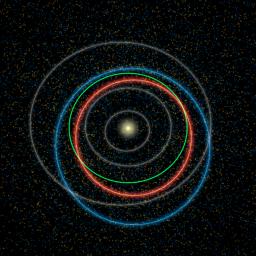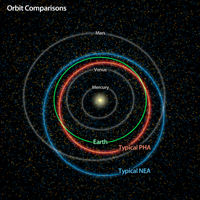
|
The Hustle and Bustle of our Solar System
- Click the image above for a larger view
- Full-Res JPEG (2016 x 2016) (508.5 kB)
- Full-Res TIFF (2016 x 2016) (12.2 MB)
Caption:

Click on the image for larger labeled version
This diagram illustrates the differences between orbits of a typical near-Earth asteroid (blue) and a potentially hazardous asteroid, or PHA (orange). PHAs are a subset of the near-Earth asteroids (NEAs). They have the closest orbits to Earth's orbit, coming within 5 million miles (about 8 million kilometers), and they are large enough to survive passage through Earth's atmosphere and cause damage on a regional, or greater, scale.
Our yellow sun sits at the center of the crowd, while the orbits of the planets Mercury, Venus and Mars are shown in grey. Earth's orbit stands out in green between Venus and Mars. As the diagram indicates, the PHAs tend to have more Earth-like orbits than the rest of the NEAs. The asteroid orbits are simulations of what a typical object's path around the sun might look like.
The dots in the background are based on data from NASA's NEOWISE, the asteroid-hunting portion of the Wide-field Infrared Survey Explorer (WISE) mission, which scanned the whole sky twice in infrared light before entering hibernation mode in 2011. The blue and orange dots represent a simulation of the population of near-Earth asteroids and the PHAs, respectively, which are larger than 330 feet (100 meters).
NEOWISE has provided the best overall look at the PHA population yet, refining estimates of their numbers, sizes, types of orbits and potential hazards. The NEOWISE team estimates that about 20 to 30 percent of the PHAs thought to exist have actually been discovered to date.
Background Info:
JPL manages, and operates the Wide-field Infrared Survey Explorer for NASA's Science Mission Directorate, Washington. The principal investigator, Edward Wright, is at UCLA. The mission was competitively selected under NASA's Explorers Program managed by the Goddard Space Flight Center, Greenbelt, Md. The science instrument was built by the Space Dynamics Laboratory, Logan, Utah, and the spacecraft was built by Ball Aerospace & Technologies Corp., Boulder, Colo. Science operations and data processing and archiving take place at the Infrared Processing and Analysis Center at the California Institute of Technology in Pasadena. Caltech manages JPL for NASA.
More information is online at http://www.nasa.gov/wise and http://jpl.nasa.gov/wise .
Cataloging Keywords:
| Name | Value | Additional Values |
|---|---|---|
| Target | ||
| System | Near Earth Objects | |
| Target Type | Asteroid | |
| Mission | Near-Earth Object Wide-field Infrared Survey Explorer (NEOWISE) | |
| Instrument Host | NEOWISE | |
| Host Type | Space Telescope | |
| Instrument | NEOWISE Telescope | |
| Detector | ||
| Extra Keywords | Atmosphere, Color, Infrared | |
| Acquisition Date | ||
| Release Date | 2012-05-16 | |
| Date in Caption | ||
| Image Credit | NASA/JPL-Caltech | |
| Source | photojournal.jpl.nasa.gov/catalog/PIA15628 | |
| Identifier | PIA15628 | |
